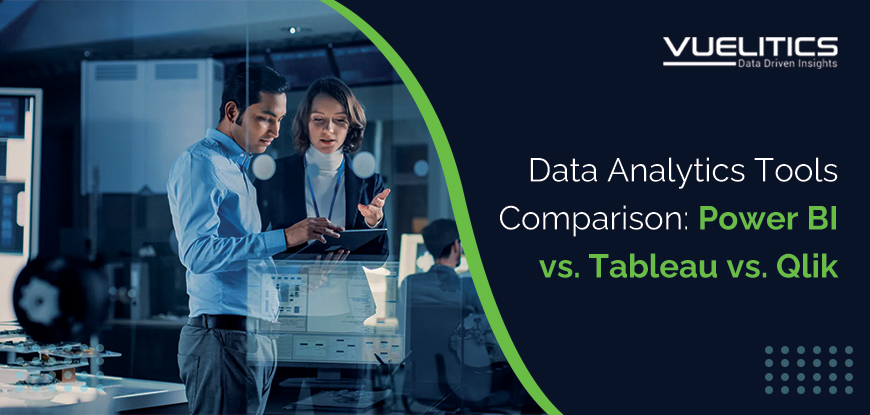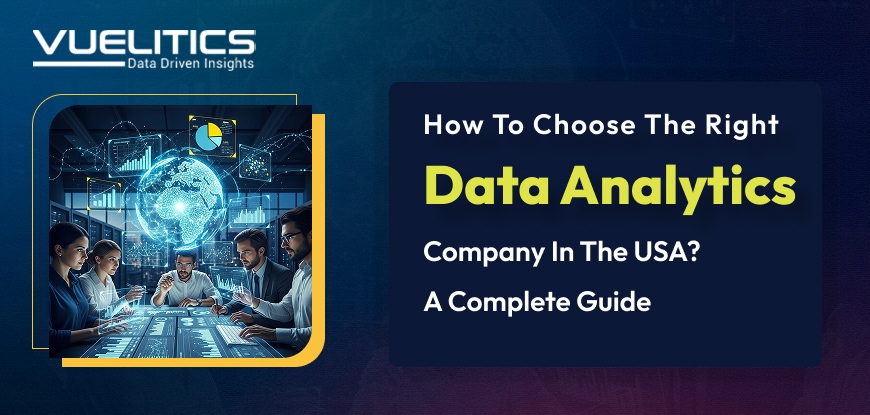- Home
- Blogs

Data Analytics Tools Comparison: Power BI vs. Tableau vs. Qlik
In an era defined by data, businesses are dependent on business intelligence tools to convert raw data into actionable insights. The leading players in the data visualization tools market include Power BI, Tableau, and Qlik. Every platform has its own unique features, pricing plans, and audience. If you are also in the dilemma of choosing one tool among these three, then this Power BI vs. Tableau vs. Qlik features comparison will help you to know the different capabilities of Power BI, Tableau and Qlik sense.
Why Make a Comparison of Power BI, Tableau, and Qlik?
All three are powerful business intelligence solutions, but the best option for you will vary based on your company’s size and industry and the amount of money in your budget. For example:
- Small businesses frequently must look for affordability and user-friendliness.
- Large businesses may want even scale and more analytics.
- Data-intensive industries likely will need deep integrations and to operate at scale.
Power BI: Microsoft’s Solution for Budget-Friendly Business Intelligence
Power BI is a solution that end-users and consultants can use to instantly create professional reports without the need for expensive designers and deadlines.
What Are the Key Features of Power BI?
Created by Microsoft, Power BI is built to be as user-friendly as possible. Some of the basic features are:
- It integrates well with Microsoft products, such as Excel and Azure.
- AI-powered insights and predictive analytics.
- Pre-built dashboards for quick reporting.
- It is very mobile-friendly for on-the-go analytics.
And when it comes to simplicity, Power BI is generally recognized as the best BI tool for small businesses.
Power BI Pricing
Power BI is famous for being cheap in terms of cost relative to its competitors. Its pricing tiers include:
- Power BI Desktop: Free, a limited version that includes the core features.
- Power BI Pro: $10 or so per user/month.
- Power BI Premium: Enterprise-grade options starting at around $20 per user/month.
From the perspective of the most cost-effective choice, Power BI vs. Tableau, meaning if we only consider the price, then Power BI is definitely the winner.
Tableau: Stunning Visuals with Enterprise Strength
What Are the Key Features of Tableau?
Tableau is acknowledged to be the major tool in the field of data visualization and data handling. It stands out with:
- Intuitive drag-and-drop dashboard creation.
- Advanced analytics and forecasting capabilities.
- Variety of big data and cloud-related input/output connectors.
- The system provides strong support for real-time analytics.
For enterprises that value data storytelling and visual oomph, they often turn to Tableau.
Tableau Pricing
Tableau is a more expensive alternative to Power BI; however, the cost of the product is designed to show its advanced features:
- Tableau Viewer: Around $15 per user/month.
- Tableau Explorer: About $42/user/month.
- Tableau Creator: Roughly $70 per user/month.
Though Tableau has all the means for in-depth analytics, it might be too much for a small company. Nevertheless, in the Tableau vs. Qlik or Tableau vs. Power BI arguments, the tableau wins if the advanced visualization gets prioritized by enterprises.
Qlik Sense Associative Data Analytics for Deeper Insights.
What Are the Key Features of Qlik Sense?
Qlik Sense stands out in this with its Associative Data Engine. Notable features include:
- Associative model for genome-wide exploration of sequence determinants of protein function.
- Self-service visualization and guided analytics.
- Deeper AI implementation for predictive analytics.
- Enterprise scalability is also found in strong governance elements.
Where Qlik is especially strong Comparing Qlik Sense versus Tableau: Who has a better data visualization? conversations through the associative search engine that enables users to find hidden trends.
Qlik Sense Pricing
The Qlik Sense platform is priced on a subscription basis and is somewhat more complicated than with Power BI and Tableau.
Qlik Sense Business: Roughly $30 per user/month. In the case of Qlik Sense Enterprise SaaS, the cost is arranged according to the requirements of big corporations. Qlik, which is more expensive than Power BI, also includes features that are specifically aimed at mid-size and enterprise companies that are looking for more comprehensive analytical capabilities.
Feature-by-Feature Showdown: Power BI vs. Tableau vs. Qlik
To compare features, here are the criteria that we can use:
| Feature Category | Power BI | Tableau | Qlik Sense |
| Ease of Use | Beginner-friendly, closely tied to Microsoft tools | Intuitive drag-and-drop but steeper learning curve | Moderate learning curve; unique associative engine |
| Data Visualization | Fine, but not quite as customizable | Data Visualization Best-in-the-class beautiful | Advanced and associative indeed |
| AI & Predictive Tools | Built-in AI insights (Cortana, Azure ML) | Strong integration with the MS ecosystem across cloud and big data platforms | Strong AI and advanced search |
| Integration | Strong with Microsoft’s ecosystem | Broad integrations across cloud and big data platforms | Wide variety, especially enterprise-grade |
| Scalability | Best for small- to mid-size businesses | Strong enterprise focus | Mid-size to large organizations |
| Pricing | Most affordable ($0–$20/user) | Premium pricing (Our range is $15 to $70 per user.) | Mid-range to high ($30+/user) |
BI Tools Comparison: Key Considerations
Power BI vs. Tableau
Power BI is more ideal for budget-minded companies and small businesses.
Tableau is ideal for big businesses that are more into data storytelling and complex dashboards.
Power BI vs. Qlik
Power BI is easier to access and less expensive.
Provides advanced associative analytics, which is used for complex data environments, such as big data.
Tableau vs. Qlik
Tableau shines in visualizations.
Besides, Qlik excels in data exploration and associations.
Qlik Sense vs. Power BI
Qlik Sense offers more robust data modeling.
Power BI delivers better affordability and Microsoft integration.
Best BI tool for small businesses: Power BI, Tableau, or Qlik?
Power BI is the obvious victor on three counts: price, simplicity and the fact that it integrates with other Microsoft programs you’re already using.
Final Verdict
The decision of Power BI vs. Tableau vs. Qlik. Which is better, is a thing only you can find out based on your organization’s objectives:
If you want a cheap and simple tool that goes well with Microsoft, choose Power BI.
You need top-notch visualizations, advanced analytics and enterprise-class scalability, then go to Tableau.
If you are looking for associative analysis and want to discover the relationships between data points, then choose Qlik Sense.
Power BI is the most cost-effective solution small businesses can rely on. For business users, Tableau and Qlik are very close competing products. Qlik with stronger associative capabilities, while Tableau outstrips the former in visualizations.
No one-size-fits-all winner is there in the end, which means the best decision is the one that fits your budget, data complexity and business requirements.
FAQs: Tableau vs. Qlik vs. Power BI.
How much does Tableau cost compared to Power BI?
Power BI is cheaper; Agile has plans for as little as $10 a user/month, and Tableau’s pricing begins at approximately 15–70 USD/user/month. Power BI is usually more cost-effective for small businesses.
What are the main Power BI features vis-a-vis Tableau and Qlik?
The main advantage of Power BI is that it has really tight integrations with Microsoft, and it’s affordable and has highly AI-based decision-making insights. Tableau is known for its robust analytical functions, whereas Qlik is distinguished by its interactive and associative data model.
When comparing Qlik Sense vs. Tableau, which is more focused on data visualization?
Tableau for intuitive, beautiful dashboards; Qlik for highly analytical, in-depth associative analysis allowing connections behind the data to be found. The decision depends on whether you value visuals (Tableau) or exploration (Qlik).
Qlik Sense vs. Power BI: Which is better?
If you need to delve deep into your data and require top-notch analytics, then you should go for Qlik Sense. Power BI suits you best if your top priorities are affordability, ease of use and excellent integration with the Microsoft ecosystem.
What is the best BI tool for small businesses: Power BI, Tableau or Qlik?
In most cases, the Power BI tool is the most suitable one when talking about small businesses. It is reasonably priced and offers a very easy way to start up. Tableau and Qlik are better for complex business data requirements.



Post Comments